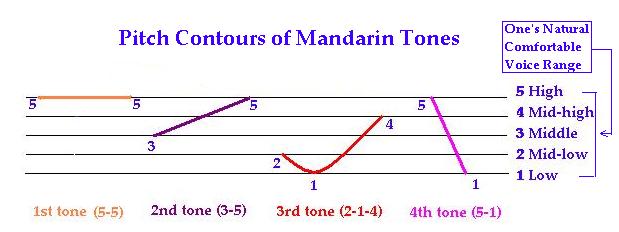In order to truly understand an art or discipline, we must understand the culture that gave rise to it. And in order to understand the culture, we must cultivate an understanding of the language. Below are common words and phrases used in our school. It is of course impossible to boil down and entire language into a brief informational page, but this can be used as a starting point from which to explore the Chinese language and the words/phrases we use in our daily classes.

Four Tones of Chinese
Some quick notes about pronunciation: standard Chinese – also referred to as Mandrin, or Pǔtōnghuà (普通话) – is a tonal language. Vowels are given tones that change the way the word is said, in turn changing the meaning. This makes the phrase, “It’s not what you say but how you say it,” very important. There are four tones:
- 1st: This is a higher-pitched, steady tone on the vowel.
- 2nd: This tone starts mid-pitched and rises towards the end of the vowel.
- 3rd: A falling-rising tone, it starts low, dips, and then increases in pitch.
- 4th: Falling tone, usually short, going from a high to low pitch
A word pronounced with the wrong tone changes meaning. But, it should be noted that even though the language is tonal, like most languages, it is also contextual. Though you can be misunderstood by having bad pronunciation of the tones – or at minimum made fun-of 😉 – the words surrounding the mispronounced word give it context, which means you will probably be understood unless you really garble your words.
Stances
马步 (mǎ bù): Horse Stance 半马步 (bàn mǎ bù): Half Horse Stance 弓步 (gōng bù): Bow Stance 仆步 (pū bù): Flat Stance 虚步 (xū bù): Empty Stance (“cat stance”) 歇步 (xiē bù): Resting Stance 独立步 (dúlì bù): One-legged Stance 并步 (bìng bù): Ready Stance (feet together) 坐盘 (zuò pán): Sit as a tray/dish
Body Parts
手 (shǒu): Hand 头 (tóu): Head 拳 (quán): Fist 脚 (jiǎo): Foot 腿 (tuǐ): Leg 大腿 (dàtuǐ): Thigh 小腿 (xiǎotuǐ): Calf 腰 (yāo): Waist 肘 (zhǒu): Elbow 腕 (wàn): Wrist 脚踝 (jiǎohuái): Ankle
Counting
一 (yī): One 二 (èr): Two 三 (sān): Three 四 (sì): Four 五 (wǔ): Five 六 (liù): Six 七 (qī): Seven 八 (bā): Eight 九 (jiǔ): Nine 十 (shí): Ten
Wushu Phrases & Techniques
压腿 (yā tuǐ): Stretching 踢腿 (tī tuǐ): Kicks / Kicking 拳法 (quánfǎ): Boxing / punching techniques 步法 (bù fǎ): Footwork / stance practice 里合腿 (lǐ hé tuǐ): Inside Crescent Kick 外摆腿 (wài bǎi tuǐ): Outside Crescent Kick 弹腿 (dàn tuǐ): Snap Kick 拍腿 (pāi tuǐ): Slap Kick 侧腿 (cè tuǐ): Side Kick 活动 (huódòng): Warm up (activity) 休息 (xiūxí): Rest 开始 (kāishǐ) – Begin 停 (tíng) – Stop 左 (zuǒ) – Left 右 (yòu) – Right 散打 (sǎndǎ) – Loose hit / free hit (“sparring”) 散手 (sàn shǒu) – Loose hand / free hand 实战姿势 (Shízhàn zīshì) – Fighting Stance (lit. “combat posture” or “real fighting position”) 进步 (jìnbù) – Forward step (lit. “progress” or “advance”) 退步 (tuìbù) – Back step (lit. “regress”) 闪步 (shǎn bù) – Sidestep 冲拳 (chōng quán) – Reverse punch 掼拳 (guàn quán) – Hook punch 抄拳 (chāo quán) – Uppercut
General Phrases
你好 (nǐ hǎo): Hello 你好吗 (nǐ hǎo ma): How are you? 谢谢 (xièxiè): Thank you 不客气 (bù kèqì): You’re welcome 再见 (zàijiàn): See You / Goodbye 对不起 (duìbùqǐ): Pardon me / I’m sorry 請 (qǐng): Please (as in “Please, may I ask…”, qǐngwèn, 請問) 好 (hǎo): Good 很好 (hěn hǎo): Very good 大好 (dàhǎo): Excellent 加油 (jiāyóu): Make an all-out effort 是 (shì): Yes 对 (duì): Correct 会 (huì): Can (as in “I can…”, wǒ huì, 我会) 不是 (bùshì): No 不对 (bùduì): Wrong / incorrect 不会 (bùhuì): Cannot 什么? (shénme): What?
